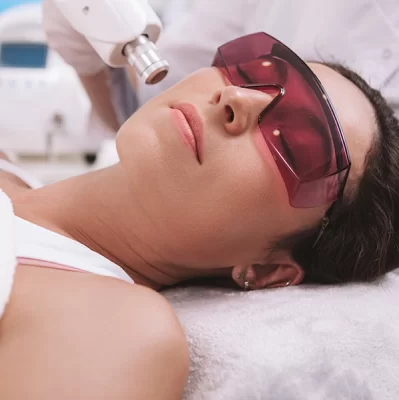Laser removal of discoloration effects
Removing discoloration with a laser is based on selective photothermolysis. The precise beam of light targets directly the melanin - the main skin pigment. Absorption of energy by the pigment leads to breaking down its molecules into small fragments. These fragments are then naturally removed by the body in metabolic processes.
The mechanism of laser discoloration removal is closely related to the chosen technology. Ablative fractional lasers work superficially, stimulating intensive exfoliation of the epidermis through controlled micro-injuries. Whereas modern non-ablative devices (e.g., picosecond) penetrate deeper, reaching the dermis - without disrupting the surface continuity of the epidermis.
Before each procedure, a medical consultation is required. To increase patient comfort during the treatment, local anesthesia is often used.
Laser treatment has a dual effect: not only significantly brightening or completely removing discolorations, ensuring the skin has a uniform color, but also intensely stimulating collagen reconstruction. The result of this stimulation is a strong skin photorejuvenation, which includes:
- improved texture,
- increased firmness,
- enhanced elasticity,
- noticeable reduction of enlarged pores,
- smoothing of fine lines.
Immediately after the session, pigmented spots may temporarily darken. This is a desired reaction, indicating the start of the natural process of shedding the fragmented pigment. Although the first results of the treatment are visible after just one visit to the office, the full and lasting effects of laser discoloration removal are provided only by a complete series of treatments. Recovery after therapy is minimal - mild redness usually subsides within a few days.
A laser utilizing the phenomenon of photothermolysis precisely targets melanin, allowing for the effective reduction of various types of discoloration – both superficial and deep. It is essential for the therapy to always be adjusted to the depth of the lesion and the individual skin characteristics of the patient.
Laser technology enables the removal or significant lightening of numerous pigmentation defects, most commonly on the face, hands, and décolletage. These include:
- sun spots, lentigines, and age spots resulting from aging and sun exposure,
- post-inflammatory hyperpigmentation (PIH) from acne or injuries,
- freckles,
- hormonal changes, e.g., melasma (chloasma),
- redness and enlarged blood vessels.
To ensure long-lasting effects of the treatment and prevent hyperpigmentation recurrence, it is essential to protect the skin from the sun. Regardless of the season and weather, apply a high UV filter cream daily - at least SPF 50. Absolutely avoid tanning beds and prolonged direct sun exposure.
Laser therapy requires special caution. Before undergoing the procedure, it is necessary to rule out contraindications such as pregnancy or breastfeeding, recent suntan, and the use of photosensitizing medications.
If you have a darker complexion, be extra vigilant. In such cases, precise selection of device parameters by a doctor is necessary for safety and treatment effectiveness.
The final price of the therapy is always determined individually. It depends on the size of the treated area and the required number of sessions.
